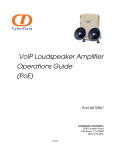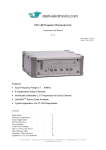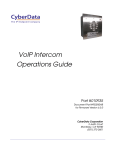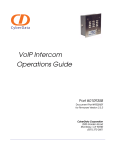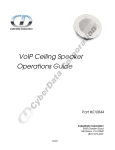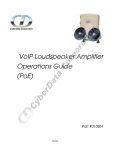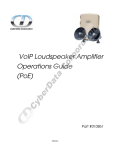Download CyberData 010935 Product specifications
Transcript
VoIP Intercom Operations Guide Part #010935A CyberData Corporation 2555 Garden Road Monterey, CA 93940 (831) 373-2601 930181E PoE VoIP Intercom Operations Guide 930181E Part # 010935A COPYRIGHT NOTICE: © 2009, CyberData Corporation, ALL RIGHTS RESERVED. This manual and related materials are the copyrighted property of CyberData Corporation. No part of this manual or related materials may be reproduced or transmitted, in any form or by any means (except for internal use by licensed customers), without prior express written permission of CyberData Corporation. This manual, and the products, software, firmware, and/or hardware described in this manual are the property of CyberData Corporation, provided under the terms of an agreement between CyberData Corporation and recipient of this manual, and their use is subject to that agreement and its terms. DISCLAIMER: Except as expressly and specifically stated in a written agreement executed by CyberData Corporation, CyberData Corporation makes no representation or warranty, express or implied, including any warranty or merchantability or fitness for any purpose, with respect to this manual or the products, software, firmware, and/or hardware described herein, and CyberData Corporation assumes no liability for damages or claims resulting from any use of this manual or such products, software, firmware, and/or hardware. CyberData Corporation reserves the right to make changes, without notice, to this manual and to any such product, software, firmware, and/or hardware. OPEN SOURCE STATEMENT: Certain software components included in CyberData products are subject to the GNU General Public License (GPL) and Lesser GNU General Public License (LGPL) “open source” or “free software” licenses. Some of this Open Source Software may be owned by third parties. Open Source Software is not subject to the terms and conditions of the CyberData COPYRIGHT NOTICE or software licenses. Your right to copy, modify, and distribute any Open Source Software is determined by the terms of the GPL, LGPL, or third party, according to who licenses that software. Software or firmware developed by CyberData that is unrelated to Open Source Software is copyrighted by CyberData, subject to the terms of CyberData licenses, and may not be copied, modified, reverse-engineered, or otherwise altered without explicit written permission from CyberData Corporation. TRADEMARK NOTICE: CyberData Corporation and the CyberData Corporation logos are trademarks of CyberData Corporation. Other product names, trademarks, and service marks may be the trademarks or registered trademarks of their respective owners. Phone: (831) 373-2601 Technical Support Ext. 333 [email protected] Fax: (831) 373-4193 Company and product information at www.cyberdata.net CyberData Corporation 930181E Operations Guide Important Safety Instructions 1. Read these instructions. 2. Keep these instructions. 3. Heed all warnings. 4. Follow all instructions. 5. Do not use this apparatus near water. 6. Clean only with dry cloth. 7. Do not block any ventilation openings. Install in accordance with the manufacturer’s instructions. 8. Do not install near any heat sources such as radiators, heat registers, stoves, or other apparatus (including apmplifiers) that produce heat. 9. Do not defeat the safety purpose of the polarized or grounding-type plug. A polarized plug has two blades with one wider than the other. A grounding type plug has two blades and a third grounding prong. The wide blade or the third prong are provided for your safety. If the provided plug does not fit into your outlet, consult an electrician for replacement of the obsolete outlet. 10. Protect the power cord from being walked on or pinched particularly at plugs, convenience receptacles, and the point where they exit from the apparatus. 11. Only use attachments/accessories specified by the manufacturer. 12. Refer all servicing to qualified service personnel. Servicing is required when the apparatus has been damaged in any way, such as power-supply cord or plug is damaged, liquid has been spilled or objects have fallen into the apparatus, the apparatus has been exposed to rain or moisture, does not operate normally, or has been dropped. 13. Prior to installation, consult local building and electrical code requirements. 14. WARNING: The VoIP Intercom enclosure is not rated for any AC voltages! Warning Electrical Hazard: This product should be installed by a licensed electrician according to all local electrical and building codes. GENERAL ALERT Warning Electrical Hazard: To prevent injury, this apparatus must be securely attached to the floor/wall in accordance with the installation instructions. GENERAL ALERT CyberData Corporation 930181E Operations Guide Pictorial Alert Icons GENERAL ALERT General Alert This pictoral alert indicates a potentially hazardous situation. This alert will be followed by a hazard level heading and more specific information about the hazard. Ground This pictoral alert indicates the Earth grounding connection point. Hazard Levels Danger: Indicates an imminently hazardous situation which, if not avoided, will result in death or serious injury. This is limited to the most extreme situations. Warning: Indicates a potentially hazardous situation which, if not avoided, could result in death or serious injury. Caution: Indicates a potentially hazardous situation which, if not avoided, could result in minor or moderate injury. It may also alert users against unsafe practices. Notice: Indicates a statement of company policy (that is, a safety policy or protection of property). The safety guidelines for the equipment in this manual do not purport to address all the safety issues of the equipment. It is the responsibility of the user to establish appropriate safety, ergonomic, and health practices and determine the applicability of regulatory limitations prior to use. Potential safety hazards are identified in this manual through the use of words Danger, Warning, and Caution, the specific hazard type, and pictorial alert icons. CyberData Corporation 930181E Operations Guide Revision History Revision Date Released Description of Changes E 4/16/2009 Revises feature description in Section 1.2, "Product Features" to the following: “Adaptive full duplex voice operation” CyberData Corporation 930181E Operations Guide CyberData Corporation 930181E Operations Guide i Contents Chapter 1 Product Overview 1 1.1 Typical System Installation ...................................................................................................................1 1.2 Product Features .....................................................................................................................................3 1.3 Supported Protocols ..............................................................................................................................3 1.4 Supported SIP Servers ...........................................................................................................................4 1.5 Product Specifications ...........................................................................................................................4 Chapter 2 Installing the VoIP Intercom 5 2.1 Parts List ..................................................................................................................................................5 2.2 Intercom Setup ........................................................................................................................................6 2.2.1 VoIP Intercom Connections .......................................................................................................6 2.2.2 Connecting a Device to the Auxiliary Relay ...........................................................................7 2.2.3 Identifying the VoIP Intercom Connectors ..............................................................................8 2.2.4 Call Button and Indicator Light ..............................................................................................10 2.2.5 Network Connectivity, and Data Rate .................................................................................. 11 2.2.6 RTFM Switch Jumper ...............................................................................................................13 2.2.7 Adjust the Volume ....................................................................................................................15 2.3 Configure the Intercom Parameters .................................................................................................16 2.3.1 Log in to the Configuration Home Page ................................................................................16 2.3.2 Configure the Network Parameters ......................................................................................18 2.3.3 Set up the Intercom ...................................................................................................................20 2.3.4 Configure the SIP Parameters .................................................................................................22 2.4 Upgrade the Firmware and Reboot the Intercom ...........................................................................24 2.4.1 Reboot the Intercom ..................................................................................................................25 Appendix A Mounting the Intercom 27 A.1 Mount the Intercom ...........................................................................................................................27 Appendix B Setting up a TFTP Server 33 B.1 Set up a TFTP Server ...........................................................................................................................33 B.1.1 In a LINUX Environment ........................................................................................................33 B.1.2 In a Windows Environment ...................................................................................................33 B.1.3 In a Solarwinds Server Environment ....................................................................................33 Appendix C Troubleshooting/Technical Support 35 C.1 Frequently Asked Questions (FAQ) .................................................................................................35 C.2 Documentation ....................................................................................................................................35 C.3 Contact Information ............................................................................................................................35 C.4 Warranty ...............................................................................................................................................36 Index Operations Guide 37 930181E CyberData Corporation ii CyberData Corporation 930181E Operations Guide 1 1 Product Overview The Voice-over-IP (VoIP) Intercom is a SIP endpoint designed to provide VoIP phone connectivity in a tamper proof and secure package. 1.1 Typical System Installation Figure 1-1, Figure 1-2, and Figure 1-3 illustrate how the VoIP Intercoms can be installed as part of a VoIP phone system. Figure 1-1. Typical Installation—Door Entry/Access Control Operations Guide 930181E CyberData Corporation 2 Product Overview Typical System Installation Figure 1-2. Typical Installation—Mass Notification Figure 1-3. Typical Installation—Emergency Phone . Warning Electrical Hazard: The VoIP Intercom enclosure is not rated for any AC voltages. GENERAL ALERT Warning Electrical Hazard: This product should be installed by a licensed electrician according to all local electrical and building codes. GENERAL ALERT CyberData Corporation 930181E Operations Guide Product Overview 3 Product Features Warning Electrical Hazard: To prevent injury, this apparatus must be securely attached to the floor/wall in accordance with the installation instructions. GENERAL ALERT 1.2 Product Features Backdoor Backdoor VoIP Intercom Backdoor ● SIP ● Dual speeds of 10 Mbps and 100 Mbps ● 802.3af compliant ● 2 gang outlet box size ● Adaptive full duplex voice operation ● Network/Web management ● Network adjustable speaker volume adjustment ● Network configurable microphone input sensitivity adjustment ● Network Downloadable product firmware ● Doubles as a paging speaker ● Call button ● Call activity indicator (light) ● Tamper proof design ● 1 dry contact relay for auxiliary control ● 3 year Warranty Backdoor 1.3 Supported Protocols The Intercom supports: ● SIP ● HTTP Web-based configuration Provides an intuitive user interface for easy system configuration and verification of Intercom operations. ● DHCP Client Dynamically assigns IP addresses in addition to the option to use static addressing. ● TFTP Client Facilitates Web-based firmware upgrades of the latest Intercom capabilities. Operations Guide 930181E CyberData Corporation 4 Product Overview Supported SIP Servers ● RTP ● RTP/AVP - Audio Video Profile ● Audio Encodings PCMU (G.711 mu-law) PCMA (G.711 A-law) Packet Time 20 ms 1.4 Supported SIP Servers The following link contains information on how to configure the Intercom for the supported SIP servers: http://www.cyberdata.net/support/voip/intercom.html 1.5 Product Specifications Category Specification Speaker Output 8 Watts Peak Power Network Rate 10/100 Mbps Power Requirement 802.3af compliant or 5V at 1000 mA Protocol SIP Part Number 010935A Dimensions 5” x 5” x 2.5” Weight 1.6 lbs./shipping weight of 2.2 lbs. Auxiliary Relay (0.7 kg/shipping weight of 1.0kg) 2 A at 30 VDC CyberData Corporation 930181E Operations Guide 5 2 Installing the VoIP Intercom 2.1 Parts List Table 2-1 illustrates the SiP VoIP and PoE Speaker parts. Table 2-1. Parts List Operations Guide Quantity Part Name Illustration 1 Intercom Assembly 1 Installation Quick Reference Guide 1 Intercom Mounting Accessory Kit 930181E CyberData Corporation Installing the VoIP Intercom Intercom Setup 2.2 Intercom Setup 2.2.1 VoIP Intercom Connections Figure 2-4 shows the pin connections on the J7 (terminal block). This terminal block can accept a wire range from 16 AWG to 26 AWG. Note As an alternative to using PoE power, you can supply 5 VDC at 1000 mA into the terminal block. Figure 2-4. VoIP Intercom Connections 6 5 Wire in, accept wire range from 16-26 AWG 4 3 2 1 - 6 J3 - Terminal Block Alternate Power Input: 1 = +5V at 1000 mA 2 = Power Ground 3 4 Relay Contact: (2A at 30 VDC or 0.4A at 125 VAC for continuous loads) 3 = Normally Open Common 4 = Normally Open Contact 5 = Door Sense Input 6 = Door Sense Ground Reference CyberData Corporation 930181E Operations Guide Installing the VoIP Intercom 7 Intercom Setup 2.2.2 Connecting a Device to the Auxiliary Relay A normally open relay is provided to enable users to switch on an auxiliary device like a door buzzer (see Figure 2-4). The relay contacts are limited to 1 amp at 30VDC. The relay on time is selectable through the web interface and is controlled by DTMF tones generated from the phone being called. The DTMF tones are selectable from the web interface as well. . Warning Electrical Hazard: The VoIP Intercom enclosure is not rated for any AC voltages. GENERAL ALERT Warning Electrical Hazard: This product should be installed by a licensed electrician according to all local electrical and building codes. GENERAL ALERT Warning Electrical Hazard: To prevent injury, this apparatus must be securely attached to the floor/wall in accordance with the installation instructions. GENERAL ALERT Note The three digit code for the auxiliary relay must be sent in conformance with RFC2833 DTMF generation. Figure 2-5. Auxiliary Relay Wiring Diagram Controlled Device Such As Electric Door Strike or Strobe Light Solid State or Mechanical Relay OUT High PIV UltraFast Switching Diode IN Output Contacts AC or DC rated Depending Upon Controlled Device Requirements AC or DC Power Source Operations Guide VoIP Intercom - 930181E DC POWER SUPPLY MAX. 30 VDC @ 1A ( ) + 6 5 4 3 2 1 CyberData Corporation 8 Installing the VoIP Intercom Intercom Setup 2.2.3 Identifying the VoIP Intercom Connectors See Figure 2-6, Figure 2-7, and Table 2-2 to identify the connectors and functions. Figure 2-6. J2, J5, and J6 Connector Locations Figure 2-7. J1 and J7 Connector Locations CyberData Corporation 930181E Operations Guide Installing the VoIP Intercom 9 Intercom Setup Figure 2-8. JP11—RTFM Switch Jumper See Table 2-2 for the connector settings. Table 2-2. Connector Settings Operations Guide Jumper Setting J1 PoE Network Connection (RJ-45 ethernet) J4 J-Tag (Factory only) J3 Terminal Block (see Figure 2-4) JP2 Call-Button/LED interface JP4 Reset (Factory only) JP5 Microphone Interface JP6 Speaker Interface JP8 Console (Factory only) JP11 RTFM (see Section 2.2.6, "RTFM Switch Jumper") 930181E CyberData Corporation 10 Installing the VoIP Intercom Intercom Setup 2.2.4 Call Button and Indicator Light 2.2.4.1 Initial Power Upon initial power or reset, you will see the following: • The light is on. • The light will blink twice to indicate that the intercom has acquired its network settings and is operational. • The first blink indicates that the intercom has acquired its network settings. • The second blink indicates that the intercom is operational. 2.2.4.2 Calling ● You may initiate a call by pressing the Call button. ● An active call is indicated by the light blinking at one second intervals. ● The intercom will automatically answer an incoming call. ● You can press the Call button to terminate an active call whether the call was an incoming call or a call that was initiated by you. Figure 2-9. Call Button and Indicator Light Call button and indicator light CyberData Corporation 930181E Operations Guide Installing the VoIP Intercom 11 Intercom Setup 2.2.5 Network Connectivity, and Data Rate When you plug in the Ethernet cable or power supply: ● The square, green Link light above the Ethernet port indicates that the network connection has been established (see Figure 2-10 and Figure 2-11). The Link light changes color to confirm the auto-negotiated baud rate: • This light is yellow at 10 Mbps. • It is orange at 100 Mbps. Figure 2-10. Network Connector Prior to Installation Ethernet Activity Link Operations Guide 930181E CyberData Corporation 12 Installing the VoIP Intercom Intercom Setup 2.2.5.1 Verify Network Activity The square, yellow Activity light blinks when there is network activity. Figure 2-11. Network Connector CyberData Corporation 930181E Operations Guide Installing the VoIP Intercom 13 Intercom Setup 2.2.6 RTFM Switch Jumper When the Intercom is operational and linked to the network, use the Reset Test Function Management (RTFM) switch (see Figure 2-12) on the Intercom board to announce and confirm the Intercom’s IP Address, test that the audio is working, and check the volume. Note You must do this test prior to final assembly. Please remember to remove the RTFM switch jumper prior to final assembly. Figure 2-12. RTFM Switch Jumper 2.2.6.1 Announcing the IP Address To announce an Intercom’s current IP address: 1. Unplug the intercom. 2. Install the RTFM jumper. 3. Plug the network cable into the intercom to supply power to the intercom. The LED will illuminate during initialization, blink once, and then turn off. 4. The intercom will announce the IP address. Note Operations Guide If you installed the RTFM jumper, and if you press the Call button for 10 seconds, the default factory settings will be restored. 930181E CyberData Corporation 14 Installing the VoIP Intercom Intercom Setup 2.2.6.2 Restoring the Factory Default Settings To restore the factory default settings: 1. Complete the steps in Section 2.2.6.1, "Announcing the IP Address". 2. Press and hold the Call button for 10 seconds. 3. When you hear the announcement, release the Call button. The factory default settings are restored, and the intercom will automatically restart. 2.2.6.3 Restore the Factory Default Settings When troubleshooting configuration problems, it is sometimes convenient to restore the device to a known state. Each Intercom is delivered with factory set default values for the parameters indicated in Table 2-3. Use the RTFM switch on the Intercom face to restore these parameters to the factory default settings. Note When you use the RTFM switch, the factory default settings are restored for only the parameters indicated in Table 2-3. The other parameters in the current Intercom configuration will remain unchanged. Table 2-3. Factory Default Settings Parameter Factory Default Setting IP Addressing static IP Address 192.168.3.10 Web Access Username admin Web Access Password admin Subnet Mask 255.255.255.0 To restore these parameters to the factory default settings: CyberData Corporation 930181E Operations Guide Installing the VoIP Intercom 15 Intercom Setup Figure 2-13. RTFM Switch Jumper To announce an Intercom’s current IP address: 1. Install the RTFM jumper. 2. After two seconds, the IP address will be announced. Note If you installed the RTFM jumper, and if you press the call button for 10 seconds, the default factory settings will be initiated. 2.2.7 Adjust the Volume You will be only able to adjust the volume through the network configuration page. Operations Guide 930181E CyberData Corporation 16 Installing the VoIP Intercom Configure the Intercom Parameters 2.3 Configure the Intercom Parameters To configure the Intercom online, use a standard web browser. Configure each Intercom and verify its operation before you mount it. When you are ready to mount an Intercom, refer to Chapter A, “Mounting the Intercom” for instructions. All Intercoms are initially configured with the following default IP settings: When configuring more than one Intercom, attach the Intercoms to the network and configure one at a time to avoid IP address conflicts. Table 2-4. Factory Default Settings Parameter Factory Default Setting IP Addressing static IP Address 192.168.3.10 Web Access Username admin Web Access Password admin Subnet Mask 255.255.255.0 Default Gateway 192.168.3.1 2.3.1 Log in to the Configuration Home Page 1. Open your browser to the Intercom IP address. For the initial configuration of the Intercom, open your browser to the default IP address: http://192.168.3.10 Note Make sure that the PC is on the same IP network as the Intercom. 2. When prompted, use the following default Web Access Username and Web Access Password to access the Home Page (Figure 2-14): Web Access Username: admin Web Access Password: admin CyberData Corporation 930181E Operations Guide Installing the VoIP Intercom 17 Configure the Intercom Parameters Figure 2-14. Home Page 3. On the Home Page, review the setup details and navigation buttons described in Table 2-5. Table 2-5. Home Page Overview Web Page Item Description Device Name Shows the device name. Serial # Device serial number. Ethernet Address Device ethernet address. IP Addressing Shows the current IP addressing setting (DHCP or static). IP Address Shows the current IP address. Subnet Mask Shows the current subnet mask address. Default Gateway Shows the current default gateway address. DNS Server 1 Shows the current DNS server 1address. DNS Server 2 Shows the current DNS server 2address. Speaker Volume (0-9) Shows the current volume level. Microphone Gain (0-9) Shows the current microphone gain level. Primary Dial-Out Shows the current primary dial-out number Link to the Intercom Setup web page. Link to the Network Setup web page. Operations Guide 930181E CyberData Corporation 18 Installing the VoIP Intercom Configure the Intercom Parameters Table 2-5. Home Page Overview Web Page Item Description Link to the SIP Setup web page. Link to the Upgrade Firmware web page. 2.3.2 Configure the Network Parameters 1. Click the Network Setup button to open the Network Setup page (Figure 2-15). Figure 2-15. Network Setup Page 2. On the Network Setup page, enter values for the parameters indicated in Table 2-6. Table 2-6. Network Setup Parameters Web Page Item Description IP Addressing* Select either DHCP IP Addressing or Static IP Addressing by marking the appropriate radio button. If you select Static, configure the remaining parameters indicated in Table 2-6. If you select DHCP, go to Step 3. IP Address* Enter the Static IP address. CyberData Corporation 930181E Operations Guide Installing the VoIP Intercom 19 Configure the Intercom Parameters Table 2-6. Network Setup Parameters Web Page Item Description Subnet Mask Enter the Subnet Mask address. Default Gateway Enter the Default Gateway address. DNS Server 1* Enter the DNS Server 1 address. DNS Server 2* Enter the DNS Server 2 address. Click this button to save your configuration settings. Changing a parameter that has an asterisk next to it will cause a system reboot when saved. Link to the Intercom Setup page. Link to the SIP Setup page. Link to the Upgrade Firmware page. Link to the Home page. 3. After changing the parameters, click Save Settings. This updates the changed parameters and reboots the Intercom if appropriate. 4. Connect the Intercom to the target network. 5. From a system on the same network as the Intercom, open a browser with the new IP address of the Intercom. Operations Guide 930181E CyberData Corporation 20 Installing the VoIP Intercom Configure the Intercom Parameters 2.3.3 Set up the Intercom 1. Click the Intercom Setup button to open the Intercom Setup page. See Figure 2-16. Figure 2-16. Intercom Setup 2. On the Intercom Setup page, enter values for the parameters indicated in Table 2-7. Table 2-7. Intercom Setup Parameters Web Page Item Description Device Name Enter a descriptive name for this device (if desired). Change Username Use this field to change the Web Access Username Change Password Use this field to change the Web Access Password Re-enter New Password Use this field to re-enter a new password Speaker Volume (0 - 9) Shows the current volume level. Microphone Gain (0 - 9) Shows the current microphone gain level. CyberData Corporation 930181E Operations Guide Installing the VoIP Intercom 21 Configure the Intercom Parameters Table 2-7. Intercom Setup Parameters Web Page Item Description Auto Answer When Auto Answer is Off, the Intercom will play a ringtone through the speaker until someone presses the button. Activate Relay During Ring With the Activate Relay During Ring option, the relay will be activated for as long as the phone is ringing. NOTE: When the phone is set to Auto Answer, it will not ring and this option does nothing. Auxiliary Relay Allows you to enable or disable the auxiliary relay. DTMF Relay Activation Code (3 digits) Use this field to enter the DTMF relay activation code. Relay Activation Duration (0 - 9 seconds) Use this field to enter the relay activation duration. Click on this button to save your configuration settings. Click on this button to do an audio test. Generates a voice message for testing the Intercom audio quality and volume. Link to the Network Setup page. Link to the SIP Setup page. Link to the Upgrade Firmware page. Link to the Home page. 3. After changing the parameters, click Save Settings. Operations Guide 930181E CyberData Corporation 22 Installing the VoIP Intercom Configure the Intercom Parameters 2.3.4 Configure the SIP Parameters 1. Click SIP Setup to open the SIP Setup page (Figure 2-17). Note For specific server configurations, go to the following URL: http://www.cyberdata.net/support/voip/intercom.html Figure 2-17. SIP Setup Page 2. On the SIP Setup page, enter values for the parameters indicated in Table 2-8. Table 2-8. SIP Setup Parameters Web Page Item Description SIP Server* Enter the SIP server represented as either a numeric IP address in dotted decimal notation or the fully qualified host name (FQHN) up to 64 characters. Outbound Proxy Enter the Outbound Proxy as either a numeric IP address in dotted decimal notation or the fully qualified host name (FQHN) up to 64 characters. Remote SIP Port* Enter the Remote SIP Port number (default 5060). Local SIP Port* Enter the Local SIP Port number (default 5060). SIP User ID* Enter the SIP User ID (up to 25 alphanumeric characters). CyberData Corporation 930181E Operations Guide Installing the VoIP Intercom 23 Configure the Intercom Parameters Table 2-8. SIP Setup Parameters Web Page Item Description Authenticate ID* Enter the Authenticate ID (up to 25 alphanumeric characters). Authenticate Password* Enter the Authenticate Password (up to 25 alphanumeric characters). SIP Registration* Enable/Disable SIP Registration. Unregister on Reboot* • Select Yes to automatically unregister the Intercom when it is rebooted. • Select No to keep the Intercom registered when it is rebooted. Register Expiration* Enter the SIP Registration lease time in minutes (default 60 minutes). Button Dial-Out: Primary Number Enter the button dial-out primary number. Click this button to save your configuration settings. Changing a parameter that has an asterisk next to it will cause a system reboot when saved. Link to the Intercom Setup page. Link to the Network Setup page. Link to the Upgrade Firmware page. Link to the Home page. 3. After changing the parameters, click Save Settings. Operations Guide 930181E CyberData Corporation 24 Installing the VoIP Intercom Upgrade the Firmware and Reboot the Intercom 2.4 Upgrade the Firmware and Reboot the Intercom To upload the Intercom firmware from your PC: 1. Set up a TFTP server. If you do not already have a TFTP server running on your network, see Appendix B, “Setting up a TFTP Server”. 2. Retrieve the latest Intercom firmware from the CyberData website: http://www.cyberdata.net/support/voip/intercom.html 3. Unzip the Intercom version file. This file may contain the following: • Firmware file: 100-uImage-intcm • Release notes 4. Copy the firmware files to be upgraded to the appropriate TFTP server directory: • c:\tftp-root\for Windows • /tftpboot/for Linux 5. Log in to the Intercom home page as instructed in Section 2.3.1, "Log in to the Configuration Home Page". 6. Click the Upgrade Firmware button to open the Firmware Upgrade page. See Figure 2-18. Figure 2-18. Firmware Upgrade Page 7. Enter the IP address of your TFTP server into the TFTP Server IP parameter field. CyberData Corporation 930181E Operations Guide Installing the VoIP Intercom 25 Upgrade the Firmware and Reboot the Intercom 8. Enter the firmware filename of the file to be uploaded into the New Filename parameter field. For example, kernel filename "201-image-spk-sip.bin". 9. Click Upload File. Note This starts the upload process. Once the Intercom has uploaded the file, the Uploading Firmware countdown page appears, indicating that the firmware is being written to flash. The Intercom will automatically reboot when the upload is complete. When the countdown finishes, the Firmware Upgrade page will refresh. The uploaded firmware filename should be displayed in the system configuration (indicating successful upload and reboot). 10. Repeat steps 8 and 9 if you are uploading the Kernel and Application files. For example, Application filename "201-romdisk-spk-sip.img". Table 2-9 shows the web page items on the Firmware Upgrade page. Table 2-9. Firmware Upgrade Parameters Web Page Item Description System Configuration Shows the current configuration. BootLoader Shows the current boot loader filename. Firmware Shows the firmware for partition 1 and 2. TFTP Server IP Enter the TFTP Server IP address. New Filename Use this field to enter the new file name for the kernel or application firmware file that you are uploading. Click on this button to automatically upload the selected firmware and reboot the system. Link to the Network Setup page. Link to the Intercom Setup page. Link to go to the SIP Setup page. Link to the Home page. Click on this button to reboot the system. 2.4.1 Reboot the Intercom To reboot a Intercom, log in to the web page as instructed in Section 2.3.1, "Log in to the Configuration Home Page". 1. Click Upgrade Firmware to open the Firmware Upgrade page (Figure 2-19). Operations Guide 930181E CyberData Corporation 26 Installing the VoIP Intercom Upgrade the Firmware and Reboot the Intercom Figure 2-19. Reboot System Section 2. Click Reboot. A normal restart will occur. CyberData Corporation 930181E Operations Guide 27 Appendix A: Mounting the Intercom A.1 Mount the Intercom Before you mount the Intercom, make sure that you have received all the parts for each Intercom. Refer to Table A-1. Table A-1. Drop Ceiling Mounting Components (Part of the Accessory Kit) Operations Guide Quantity Part Name 2 Outlet Box Plugs 2 Flush Mounting Plate 2 8-32 x 1/4" Flat Head Phillips Machine Screw 1 10-24 x 5/16" Pan Head Phillips Machine Screw 930181E Illustration CyberData Corporation 28 Mount the Intercom To mount the Intercom: 1. Plug the Ethernet cable into the Intercom Assembly (see Figure A-1). Section 2.2.5, "Network Connectivity, and Data Rate" explains how the Link and Status LEDs work. Figure A-1. Network Connector Prior to Installation CyberData Corporation 930181E Operations Guide 29 Mount the Intercom 2. To fasten the Intercom: • For wall mounting, use the two 8-32 X 1/4" FLAT HEAD PHILLIPS MACHINE SCREW and the one 10-24 X 5/16" PAN HEAD PHILLIPS MACHINE SCREW to secure the Intercom. Figure A-1. VoIP Intercom Assembly 4 x Mounting Screw Face Plate and PCB Assembly 2 Gang Box Operations Guide 930181E CyberData Corporation 30 Mount the Intercom If the thread on the conduit is longer than 3/8 inch, then a stop nut (not supplied) is required. Otherwise, use the outlet box plug to plug the exit hole. Figure A-2. Mounting the VoIP Intercom Assembly HOLE PLUG OR CONDUIT (1/2”) Figure A-3 shows the restrictions of the conduit going into the box. Figure A-3. Conduit Restrictions Not to Exceed 0.1" CyberData Corporation 930181E CONDUIT (1/2”) Operations Guide 31 Mount the Intercom Figure A-4 shows how to properly mount the VoIP Intercom. Figure A-4. Mounting Flush Mounting Plate (2 x) Flat Head Phillips Machine Screw (2 x) Mounting Screw Not Provided Operations Guide 930181E CyberData Corporation 32 Mount the Intercom CyberData Corporation 930181E Operations Guide 33 Appendix B: Setting up a TFTP Server B.1 Set up a TFTP Server Upgrading the VoIP Intercom firmware requires a TFTP server on which you access the Web interface where you can upload the firmware files. B.1.1 In a LINUX Environment To set up a TFTP server on LINUX: 1. Create a directory dedicated to the TFTP server, and move the files to be uploaded to that directory. 2. Run the following command where /tftpboot/ is the path to the directory you created in Step 1: the directory that contains the files to be uploaded. For example: in.tftpd -l -s /tftpboot/your_directory_name B.1.2 In a Windows Environment You can find several options online for setting up a Windows TFTP server. This example explains how to use the Solarwinds freeware TFTP server, which you can download at: http://www.tucows.com/preview/326445 To set up a TFTP server on Windows: 1. Install and start the software. 2. Select File/Configure/Security tab/Transmit Only. 3. Make a note of the default directory name, and then move the firmware files to be uploaded to that directory. B.1.3 In a Solarwinds Server Environment You can find several options online for setting up a Solarwinds server. This example explains how to use the Solarwinds freeware TFTP server, which you can download at: http://www.cyberdata.net/support/voip/solarwinds.html Operations Guide 930181E CyberData Corporation 34 Set up a TFTP Server CyberData Corporation 930181E Operations Guide 35 Appendix C: Troubleshooting/Technical Support C.1 Frequently Asked Questions (FAQ) Go to the following URL to see CyberData’s list of frequently asked questions: http://www.CyberData.net/support/voip C.2 Documentation The documentation for this product is released in an English language version only. You can download PDF copies of CyberData product documentation at: www.CyberData.net—>Support—>Drivers, Utilities & Manuals—>VoIP Products C.3 Contact Information Contact CyberData Corporation 2555 Garden Road Monterey, CA 93940 USA www.CyberData.net Phone: 800-CYBERDATA (800-292-3732) Fax: 831-373-4193 Sales Sales 831-373-2601 Extension 334 Technical Support Phone: 831-373-2601 Extension 333 Email: [email protected] Returned Materials Authorization To return the product, contact the CyberData Returned Materials Authorization (RMA) department at: Phone: 831-373-2601, Extension 136 Email: [email protected] When returning a product to CyberData, an approved CyberData RMA number must be printed on the outside of the original shipping package. No product will be accepted for return without an approved RMA number. Send the product, in its original package, to the following address: CyberData Corporation 2555 Garden Road Monterey, CA 93940 Attention: RMA "your RMA number" Operations Guide 930181E CyberData Corporation 36 Warranty C.4 Warranty CyberData warrants its product against defects in material or workmanship for a period of two years from the date of purchase. Should the product fail within the warranty period, CyberData will repair or replace the product free of charge. This warranty includes all parts and labor. If the product is out-of-warranty and fails, a flat rate repair charge of one half the product purchase price will be assessed. Repair costs for products that are in warranty, but damaged by improper modifications or abuse, will be charged at the out-of-warranty rate. Products returned to CyberData, both in and out-of-warranty, are shipped to CyberData at the expense of the customer. Charges for shipping repaired products back to the customer will be paid by CyberData. CyberData Corporation 930181E Operations Guide 37 Index subnet mask 14, 16 username and password 14, 16 web login username and password 16 default gateway 16, 19 default intercom settings 14 default IP settings 16 default login address 16 DHCP Client 3 DHCP IP addressing 18 dimensions 4 DNS server 19 dual speeds 11 Numerics 100 Mbps indicator light 11 A AC voltages 2, 7 act light 12 activate relay during ring 21 address, configuration login 16 announcing a intercom’s IP address 13, 14, 15 asterisk 19 audio encodings 4 auto answer 21 auxiliary relay 21 auxiliary relay wiring diagram 7 auxiliary relay, connecting a device to 7 E ethernet cable 28 expiration time for SIP server lease 23 F B factory default settings 14 firmware upgrades 33 baud rate verifying 11 G C green link light 11 changing the web access password 20 conduit restrictions 30 configurable parameters 17, 18, 20, 22, 25 configuration default IP settings 16 network 18 SIP 22 using Web interface 16 configuration home page 16 CyberData contact information, corporate, sales, tech support, service 35 H home page 16 http web-based configuration 3 I illustration of intercom mounting process 27 installation, typical intercom system 1 intercom configuration default IP settings 16 intercom configuration page configurable parameters 17, 18, 20, 22, 25 intercom operations, verifying 20 intercom setup 20 IP address 14, 16, 18, 25 D default gateway 16 intercom settings 37 IP address 14, 16 Operations Guide 930181E CyberData Corporation 38 IP addressing 18 default setting 14, 16 product overview product features 3 product specifications 4 supported protocols 3 supported SIP servers 4 typical system installation 1 product specifications 4 protocols supported 3 L lease, SIP server expiration time 23 link LED 28 link light 11 Linux, setting up a TFTP server on 33 local SIP port 22 log in address 16 R reboot 25 registration and expiration, SIP server lease 23 remote SIP port 22 reset test function management switch 13 resetting the IP address to the default 27, 35 restoring factory default settings 14, 37 RJ-45 9 RMA returned materials authorization 35 RTFM jumper 9, 13, 15 RTFM jumper switch 13 RTFM switch 13, 14 RTP/AVP 4 M mounting an intercom 27 N network activity, verifying 12 network configuration of intercom 18 network rate 4 Network Setup 18 S server address, SIP 22 setting up a TFTP server 33 setting up an intercom 6 settings, default 14 SIP (session initiation protocol) 3 SIP Configuration 22 SIP configuration SIP Server 22 SIP registration 23 SIP server 22 SIP servers supported 4 solarwinds 33 speaker output 4 static IP addressing 18 status LED 28 subnet mask 14, 16, 19 supported protocols 3 O orange link light 11 outbound proxy 22 P packet time 4 part number 4 parts list 5 password changing for web configuration access 20 for SIP server login 23 login 16 restoring the default 14, 16 port local SIP 22 remote SIP 22 power requirement 4 product configuring 16 mounting 27 parts list 5 product features 3 CyberData Corporation T technical support, contact information 35 TFTP server 3, 33 930181E Operations Guide 39 U unregister, from SIP server 23 user ID for SIP server login 23 user ID, SIP 22 username changing for web configuration access 20 default for web configuration access 16 restoring the default 14, 16 V verifying baud rate 11 intercom operations 20 network activity 12 network connectivity 11 W warranty 36 web access password 14, 16 web access username 14, 16 web configuration log in address 16 web-based intercom configuration 16 weight 4 Windows, setting up a TFTP server on 33 Y yellow act light 12 yellow link light 11 Operations Guide 930181E CyberData Corporation 40 CyberData Corporation 930181E Operations Guide

















































